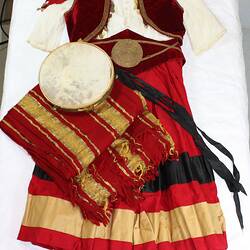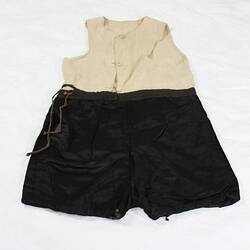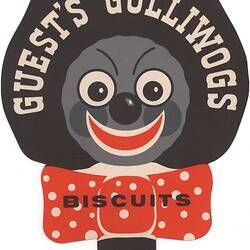Summary
Seven-piece child's costume, comprising shirt, vest, belt, skirt, scarf, headdress and tambourine. It dates to the mid to late 19th century and is said to come from the station 'Buangor' in western Victoria. The costume would have been used for role play, and possibly for theatrical performances.
The costume provides a rare insight into children's entertainment and play in a socially active 19th century rural community, whether used by Campbell family or others living at the estate. Buangor township soon became a socially active community, with locals organising regular balls, dances, theatre shows, tea parties, races and picnics where children's entertainment was arranged.
'Buangor' was established in 1849 by pastoralist and parliamentarian Colin Campbell (1817-1903), married to Frances Elliott Macwhirter (1827-1883) and later Emily Ashby Sheffield. He had 13 children, of whom nine survived him. The Campbell family lived in Gardiner (Malvern) for most of the 1850s. Campbell was Member of the Legislative Council for Rippon, Hampden and other electorates 1854-59, leaving the property to be managed by a David Clarke. Around 1859 they returned to 'Buangor', and were soon part of a growing community in the newly settled township of Buangor (established 1861). In 1864 Campbell sold the homestead to concentrate on standing for the Legislative Assembly seat of Ararat (he was unsuccessful on this occasion). In 1875 he re-purchased the property and took pride in the opening of the railway line to Buangor township in March 1875 as a local MLA. He became an ordained priest (Church of England) in 1878, and moved around Victorian parishes in that role. He re-sold 'Buangor' in 1885, at the age of 68. The station was eventually dismantled in November 1898.
The name in the skirt waistband 'Crewdsons' relates to the material from which it was made. Crewdson's was a long-established textile manufacturer based in Preston, Lancashire, UK. As early as 1850, the Sydney Morning Herald was advertising 'Howard and Crewdson's super, extra stout shirtings' (27 August 1850, p.1) and on 14 December 1850 (p.5), 'Crewdson's and Greenwood's Shirtings'. In 1888, several cotton manufacturers and pattern makers merged to form Horrockses, Crewdson & Co. in Preston, Lancashire, creating an enormous enterprise with 5,300 employees, 7,000 looms and 250,000 spindles. An advertisement in the Adelaide Advertiser on 21 July 1911 offers 'Crewdsons calicos and ladies costumes', on sale at the F.C. Catt Stores, 64-72 Rundle Street, Adelaide, and as late as 1949 Crewdson's calico was still being advertised in Australian newspapers (Morning Bulletin [Rockhampton, Queensland] 8 July 1949, p.9).
This object includes what is for some people a cultural stereotype. Such representations are not condoned by Museums Victoria, which considers them to be racist. Historical distance and context do not excuse or erase this fact. The costume might be considered 'gypsy' in style. The word 'gypsy' is a complex term: a cultural stereotype with often derogatory connotations, yet it is also a term which some Romani peoples own and with which they identify.
Physical Description
Seven-piece child's costume, comprising shirt, vest, belt, skirt, scarf, headdress and tambourine. It is machine-sewn with hand finishing. The shirt is cream-coloured light-weight cotton, gathered at the sleeves and waist, centre back and either side of the front opening. It has a turned up 'gypsy-style' collar and 14 matching cream-coloured carved mother-of-pearl buttons (bottom one missing) and three hooks at the front opening. The bodice is lined with heavier cream-coloured fabric. The sleeveless vest is red velvet with openings trimmed with gold cord. The front opening and hem are trimmed with brass (or similar) faux coins (most now missing), with mock Cyrillic writing. The vest is lined with white fabric with fine purple lines; the visible edges are heavily pinked. Two hooks fasten the front of the vest. The belt is red velvet with gold cord, matching the vest. It widens out to points at the fastening and centre, where the cord is wound around to form a large circle. The belt is lined with maroon satin fabric; it is fastened with nine metal hooks and eyes. It is stiffened with five flat stays sewn into the lining, one of which is visible, and is possibly baleen (a whale product). The skirt is made of heavily-gathered red fabric, with a wide black silk stripe above a wide cream silk stripe (now very discoloured), hand-sewn with running stitch. It has a narrow white waistband (calico or similar) with two hook fasteners, and is unlined. The red fabric is peppered with irregular holes - apparently moth-eaten. The scarf is a large rectangle of striped red and yellow with gold thread fabric, fringed at the end. The fabric has linear ridges, and has torn along the ridges in some places due to its fragility. The headdress is turban-style, of semi-translucent fabric in a checked weave puckered into a searsucker effect. It is wound around wire to form a head shape, held into place with grey stiffening, and cascading into a tail. It is rimmed with brass (or similar) faux coins, with mock Cyrillic writing, and is lined with black fabric under the crown. A single baleen (or similar) stay would have helped to secure the headpiece, and two brass safety pins secure the fabric in place. The tambourine is made from wood with a natural animal skin. The wood is painted olive on the outside and orange on the inside. It has three zils (metal jingles) and originally also had three bells, although one is now missing. It has a long 66cm trail of four lengths of black ribbon, one pair looped.
Significance
Statement of Signifiance:
The costume has multiple layers of significance. It provides a rare material record of children's entertainment and play in a socially active 19th century rural community. It is believed to have been used at 'Buangor', a 19th century homestead in western Victoria, established in 1849 by Colin Campbell and eventually dismantled in November 1898. From the 1860s onwards the local township of Buangor was a socially active community, with regular balls, dances, theatre shows, tea parties, races and picnics where children's entertainment was arranged.
The outfit shows considerable attention to detail, with seven colourful pieces incorporating both hand and machine stitching. The detailing and use of varied fabrics in the costume's production suggests the original owners' affluence. This is supported by historical records which show that families in Buangor and the surrounding districts were fairly prosperous, even during the 1890s economic depression.
Child's play can unwittingly (or deliberately) draw on or appropriate cultural stereotypes, as seen in this costume. Adult cultural practices can do the same. Peoples who have been known by the pejorative term 'gypsy' have been part of Australian popular culture and associated with entertainment and the exotic since the 19th century. But the word is a cultural stereotype and can be a derogatory slur. Such words and sentiments are not condoned by Museums Victoria.
'Gipsy encampments' were periodically held - for example, a 'gipsy's encampment' at the Camp Reserve, Bendigo, on 29-30 March 1875 to raise funds for charity, part of a 'Grand Fair' that featured boating, dancing, sports, 'theatricals', music, waxworks, juggling and a 'Fire Brigade torchlight procession' (Bendigo Advertiser, 27 February 1875, p.1, and 25 March 1875, p.1). Interestingly, the Campbell family had recently returned to live in Buangor in early 1875, and Colin Campbell took pride in the opening of the railway line to Buangor township in March 1875 as a local MLA. (Today Bendigo today is a two-hour drive from Buangor, so it is unlikely that the family would have visited Bendigo for the 'gipsy encampment'.) Similarly, a 'Grand Gipsy Encampment & Fancy Fair' was held in Carlton on 27-29 April 1885 (refer REB 002420). The event was a fund-raiser for St George's Roman Catholic Church, and featured tents sold by 'ladies dressed in various gipsy [sic] costumes' (The Argus, 7 April 1885, p.7). The model continued into the 20th century, with a 'gypsy encampment' with '39 gypsies in a special caravan', merry-go-rounds and other fair attractions was held at the Glenferrie sports ground held from 16 February 1918 (Argus, 14 February 1918, p.12). In some circumstances cultural Roma people are likely to have been involved. Roma peoples migrated to Australia from the earliest days of settlement, and some travelled with (and probably in some cases organised) fairs that travelled around populated areas of Australia. (The Powerhouse Musueum's provenance notes for its 'gypsy' caravan provides an extended discussion of this topic.)
More Information
-
Collecting Areas
-
Acquisition Information
Donation from (Estate of) Maureen Christie, Art Gallery of Ballarat, Mr Gordon Morrison - Art Gallery of Ballarat, Jun 2010
-
Date Used
'Buangor' estate, Ballarat District, Victoria, Australia, 1849-1899
-
Inscriptions
On skirt, printed on inside of waistband: 'CREWDSONS'
-
Classification
-
Category
-
Discipline
-
Type of item
-
Part Dimensions
790 mm (Width), 453 mm (Height)
Dimensions of Shirt - measured laid flat with arms outstretched.
-
Part Dimensions
390 mm (Width), 370 mm (Height)
Dimensions of Vest - measured laid flat.
-
Part Dimensions
685 mm (Height)
Dimensions of Skirt - measured laid flat.
-
Part Dimensions
210 mm (Outside Diameter)
Dimensions of Headpiece.
-
Part Dimensions
42 mm (Height), 232 mm (Outside Diameter)
Dimensions of Tambourine.
-
References
Grace's Guide to British Industrial History - information on merger of Horrockses, Crewdson and Co. at [Link 1] accessed 5/9/2012.
-
Keywords
Role Play, Children's Play, Clothing, Cultural Stereotypes, Fancy Dress






